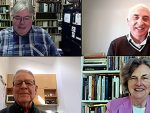Bishop Michael Gielen’s decision to remove the faculties of the clerical members of the Sons of the Most Holy Redeemer and to ask them to leave the diocese is a courageous act.
The scandal-plagued group came to prominence through their illicit use of the rites of exorcism and have been investigated by both the local media and by the Church.
One must hope that the other New Zealand bishops will support Bishop Gielen by not undercutting his decision by offering this fringe group a home in their dioceses.
The Sons of the Most Holy Redeemer are an excellent example of the reasons why Pope Francis wrote his letter (motu proprio) Traditionis custodes (Guardian of Tradition) in 2021 to the bishops.
In it, he restricted the use of the 1962 Missal and removed the incorrect distinction of “ordinary” and “extraordinary” forms of the Mass that Pope Benedict XIV in his letter (motu proprio) Summorum pontificium (2007) had introduced.
The bishops are the protectors of the authentic tradition of the Church and are not there to further a fringe group.
They must be concerned for the unity of the Church and for the liturgical unity of their dioceses, in this they have been given a clear direction by Pope Francis.
Traditionis custodes
In Traditionis custodes, Pope Francis affirmed that the Latin Church has one Lex Orandi or one law of prayer.
The exceptions to this are ancient rites such as in Milan or in Spain.
Further exceptions are where a group of the baptised leave the communion of the Church to establish their own ecclesial communion and worship using their own rites, as happened following the early schisms of the Church and the European Reformation.
At the end of the First Vatican Council the Old Catholic Church was set up by those who disagreed with the theology of papal infallibility.
Traditionis custodes forbids the use of the 1962 in parish churches without Roman permission.
It requires every priest wanting to celebrate this form to seek the explicit permission of his bishop. It also requires any seminarian, ordained after 2021, who wishes to use these rites, to have the Vatican’s permission.
In February 2023, Francis tightened the rules again when he removed the diocesan bishops’ authority to grant dispensations for the 1962 Missal by transferring this to his liturgical office.
It was stipulated that bishops may not dispense from the prohibition of the celebration of the pre-conciliar liturgy in parish churches and must seek the explicit permission of the Holy See.
This has led to the refusal of Archbishop Comemsoli’s request to use the Melbourne Cathedral, because of the role a cathedral plays as the “parish church of the diocese”.
How we pray shows what we believe
One of the main reasons for the restrictions on use of the 1962 missal and associated rites used before the Second Vatican Council is what these rites mean theologically.
Liturgical rites have meaning and liturgical rituals express an inner meaning of belief, which is why the liturgy is called a lex orandi, or a law of prayer.
While many people might have a transactional understanding of the Mass and not care about what is said or done—as long as its quick—how we pray matters.
The way we pray identifies for oneself and to others what we believe. So in the 1950 rite of Good Friday where the Church prayed for the “perfidious Jews”, no one blinked an eye at the deep antisemitism.
When now we pray for the “Jewish People, the first to hear the word of God” we pray differently. In the 1962 rite, only the priest prayed the Mass and everyone else attended, now we all the pray the Mass.
These differences are key to understanding the ecclesiological difference between these rites.
For those who choose one over the other there should be respect for their choice. Those to try to celebrate in both rites create a schizophrenic relationship to the Church.
Magisterium and Liturgy
Pope Benedict XVI wrote that the Constitution on the Sacred Liturgy, Sacrosanctum Concilium (1963) came first because the liturgy is the heart and centre of the Church’s life.
We are not a social club, but a community of the baptised who worship God and seek to live the Gospel of Christ in our daily living.
The Second Vatican Council is the highest teaching authority of the Church of the pope and bishops, in Council.
The baptised listen to the Spirit guiding the Church through the Church’s magisterium. To deny this is to turn ones back on the Church and to call into question the reality of one’s baptism.
Since the Council, most so-called “Latin Mass” groups have become deniers of the magisterium of the bishops and pope in Council.
A recent example of this is the ordinations of priests in the traditionalist Society of Saint Pius X (SSPX) in the Bavarian diocese of Regensburg.
The diocesan Bishop, Rudolf Voderholze, emphasized that the SSPX’s ordinations were unauthorized and violated ecclesiastical norms. He also expressed hope for the SSPX’s genuine efforts to return to full communion with the Catholic Church, respecting canonical regulations.
The current situation is not helped by the sending of mixed messages.
While traditionalist groups like the Institute of Christ the King continue to celebrate the pre-conciliar Mass based on their statutes, but the seminarians of the traditionalist Missionaries of Divine Mercy in France are refused permission for ordination based on their adherence to pre-conciliar liturgy, nothing is clear.
The Sons of the Most Holy Redeemer have received this judgment and expulsion because they crossed a very important line and used liturgical rituals in an abusive way.
They are not to be trusted as representative of the Church. Those who would support them need to examine their own consciences as to reasons they are doing so.
- Dr Joe Grayland is New Zealand’s only liturgically trained theologian. He is teaching at the University of Tubingen, Germany.
News category: Analysis and Comment.




